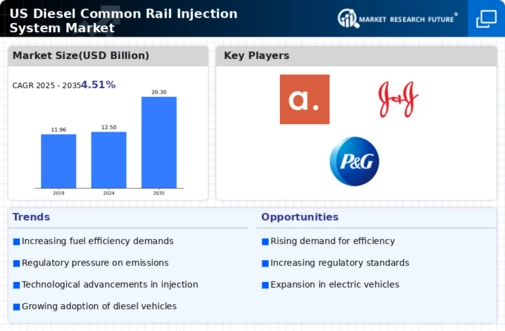Increasing Fuel Efficiency Standards
The diesel common-rail-injection-system market is experiencing a notable push due to the increasing fuel efficiency standards mandated by regulatory bodies in the US. These standards require manufacturers to enhance the fuel economy of vehicles, which in turn drives the adoption of advanced diesel common-rail injection systems. These systems are designed to optimize fuel atomization and combustion, leading to improved efficiency. As of 2025, the average fuel economy for light-duty vehicles is targeted to reach approximately 54.5 mpg, which necessitates the integration of sophisticated injection technologies. Consequently, manufacturers are investing in research and development to innovate and refine diesel common-rail systems, thereby propelling market growth.
Shift Towards Cleaner Diesel Technologies
The diesel common-rail-injection-system market is significantly influenced by the shift towards cleaner diesel technologies. With increasing environmental concerns and stringent emissions regulations, there is a growing demand for diesel engines that produce lower emissions. The adoption of common-rail injection systems allows for better control of fuel delivery, resulting in reduced particulate matter and nitrogen oxides. In 2025, it is estimated that the market for cleaner diesel technologies will grow by approximately 15%, as manufacturers strive to meet the Environmental Protection Agency's (EPA) standards. This transition not only enhances the performance of diesel engines but also aligns with the broader trend of sustainability in the automotive sector.
Technological Integration with Hybrid Systems
The diesel common-rail-injection-system market is witnessing a trend towards technological integration with hybrid systems. As the automotive industry evolves, there is a growing interest in combining diesel engines with electric powertrains to enhance overall efficiency and reduce emissions. This hybridization allows for the benefits of diesel's torque and fuel efficiency while leveraging electric power for improved performance. By 2025, it is anticipated that hybrid diesel systems will capture a notable share of the market, as manufacturers explore innovative designs that incorporate common-rail injection technology. This integration not only meets consumer demand for greener alternatives but also aligns with regulatory pressures for lower emissions.
Expansion of Diesel Common-Rail Systems in Emerging Markets
The diesel common-rail-injection-system market is poised for expansion as manufacturers look to penetrate emerging markets. Countries in Asia and South America are experiencing rapid industrialization and urbanization, leading to increased demand for diesel-powered vehicles. The versatility and efficiency of common-rail injection systems make them attractive for these markets, where fuel economy and performance are critical. As of 2025, it is projected that the demand for diesel engines in emerging markets will grow by approximately 20%, prompting manufacturers to adapt their strategies to cater to these regions. This expansion not only opens new revenue streams but also encourages innovation in diesel common-rail technologies to meet diverse market needs.
Rising Popularity of Diesel Engines in Heavy-Duty Applications
The diesel common-rail-injection-system market is benefiting from the rising popularity of diesel engines in heavy-duty applications, such as trucks and construction equipment. Diesel engines are favored for their durability, torque, and fuel efficiency, making them ideal for demanding tasks. As of 2025, the heavy-duty vehicle segment is projected to account for over 60% of the diesel engine market share in the US. This trend is driving manufacturers to invest in advanced common-rail injection systems that enhance performance and reduce emissions. The increasing demand for logistics and transportation services further fuels this growth, as businesses seek reliable and efficient solutions for their operations.














Leave a Comment